Finding the right wheel for your vehicle shouldn’t feel like solving a complex puzzle. We’ve all been there – standing in the auto parts store or browsing online catalogs wondering if that perfect set of wheels will actually fit our car. The key to avoiding costly mistakes lies in understanding your vehicle’s 5 lug bolt pattern.
Most modern vehicles use a 5-lug configuration and knowing your exact measurements can save you time money and frustration. Whether you’re upgrading to aftermarket wheels or replacing damaged ones we understand how important it is to get the fitment right the first time.
That’s why we’ve created a comprehensive printable 5 lug bolt pattern chart that puts all the essential information right at your fingertips. Our detailed chart eliminates the guesswork and gives you the confidence to make informed wheel purchasing decisions without endless research or multiple trips to the store.
What Is a 5 Lug Bolt Pattern Chart
A 5 lug bolt pattern chart displays the precise measurements and specifications for vehicles equipped with five-bolt wheel mounting systems. This reference tool organizes critical data including bolt circle diameter measurements, thread specifications, and compatible vehicle applications in an easy-to-read format.
Our comprehensive chart eliminates guesswork by providing exact measurements for popular 5×100, 5×108, 5×110, 5×112, 5×114.3, 5×115, 5×120, and 5×127 bolt patterns. Each entry includes the pitch circle diameter (PCD) measured in millimeters, which represents the distance across the circle formed by the center points of the bolt holes.
Vehicle manufacturers use exact bolt patterns to ensure proper wheel fitment and safety. The chart categorizes these patterns by make and model, covering domestic brands like Ford, Chevrolet, and Dodge alongside imports including Honda, Toyota, BMW, and Audi. Popular applications include the 5×114.3 pattern found on Mustangs, Camaros, and many Japanese vehicles, while European cars typically feature 5×112 or 5×120 configurations.
Printable formats allow mechanics and enthusiasts to access this information offline during wheel selection or installation processes. The standardized layout presents measurements in both metric and imperial units, accommodating different user preferences and regional standards. Quick reference sections highlight the most common patterns, while detailed tables provide comprehensive coverage of less frequent applications.
Professional tire shops and automotive retailers rely on these charts to verify compatibility before completing wheel purchases. The organized presentation reduces measurement errors and prevents costly fitment mistakes that could compromise vehicle safety or performance.
Benefits of Using a Printable 5 Lug Bolt Pattern Chart
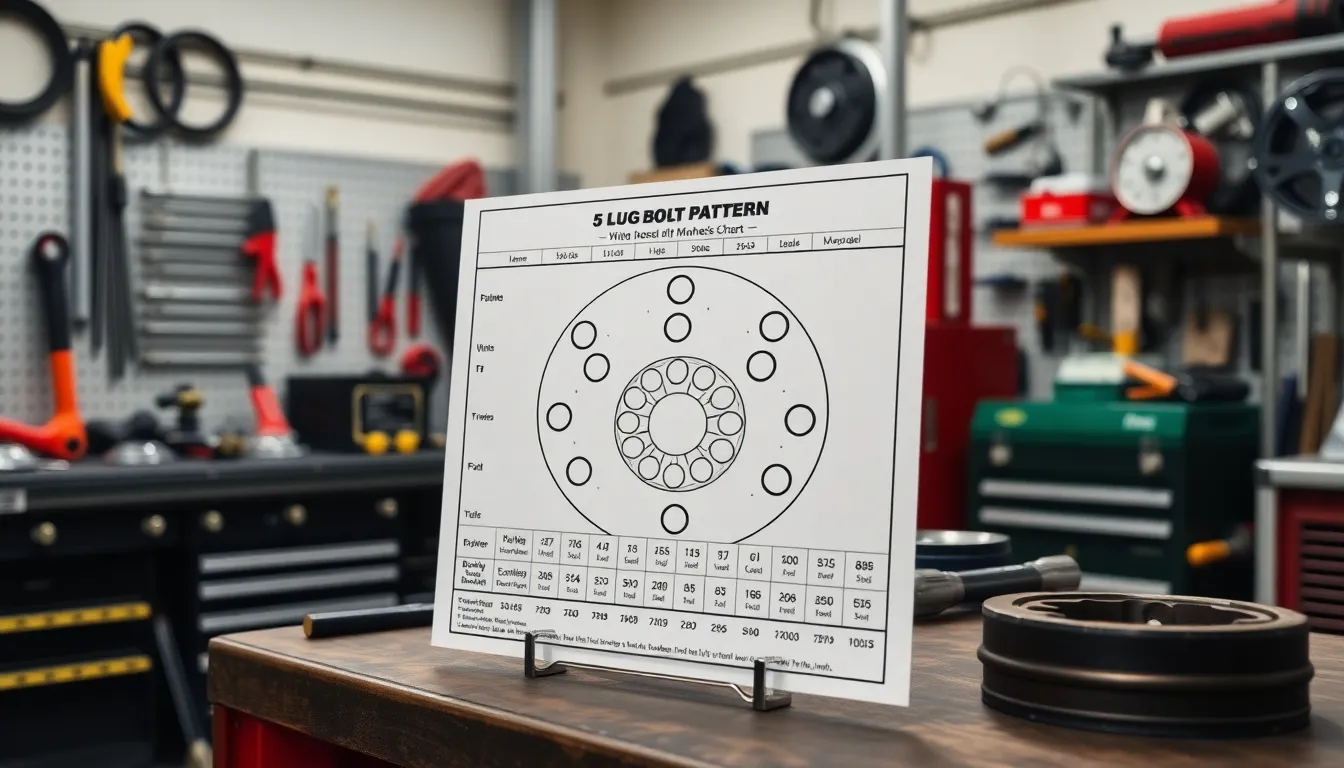
Printable 5 lug bolt pattern charts transform complex wheel fitment verification into a straightforward process. These practical tools eliminate measurement confusion while providing instant compatibility confirmation for automotive enthusiasts and professionals.
Quick Reference for Wheel Shopping
Shopping for wheels becomes significantly more efficient when you carry a printable bolt pattern chart. Automotive retailers stock hundreds of wheel options with varying 5-lug configurations including 5×4.5″, 5×5″, and 5x120mm patterns that can confuse even experienced buyers. Physical templates allow instant verification by aligning template holes with wheel mounting surfaces, preventing costly purchasing mistakes.
Online wheel shopping benefits tremendously from having printed references nearby during browsing sessions. Comparing specifications becomes more accurate when you can physically test bolt patterns rather than relying solely on manufacturer listings that sometimes contain errors. Returns and exchanges drop dramatically when customers use these verification tools before completing purchases.
Easy Garage Organization Tool
Workshop efficiency improves when mechanics keep printed bolt pattern guides within easy reach of work areas. Identifying 5-lug patterns during routine maintenance or emergency repairs saves valuable time that would otherwise be spent measuring individual stud spacing. Professional shops report faster turnaround times when technicians can quickly reference printed charts instead of using complex measuring tools.
Storage answers become more practical with laminated charts that resist oil stains and shop debris. Multiple copies can be placed at different work stations, ensuring every technician has immediate access to bolt pattern information. DIY enthusiasts organize their home garages more effectively by posting these reference materials near wheel storage areas.
Cost-Effective Solution for DIY Mechanics
Budget conscious mechanics save hundreds of dollars by using printable templates instead of purchasing specialized bolt pattern gauges. Professional measuring tools can cost $50-150 while printable charts require only paper and ink to produce multiple copies. Home printers generate these templates for less than $1 per sheet, making them accessible for hobbyists working on tight budgets.
Replacement costs remain minimal when charts become damaged or worn from regular use. New copies print instantly without waiting for shipping or visiting automotive supply stores. Small repair shops reduce overhead expenses by eliminating the need for multiple expensive measuring tools across different work stations.
How to Read a 5 Lug Bolt Pattern Chart
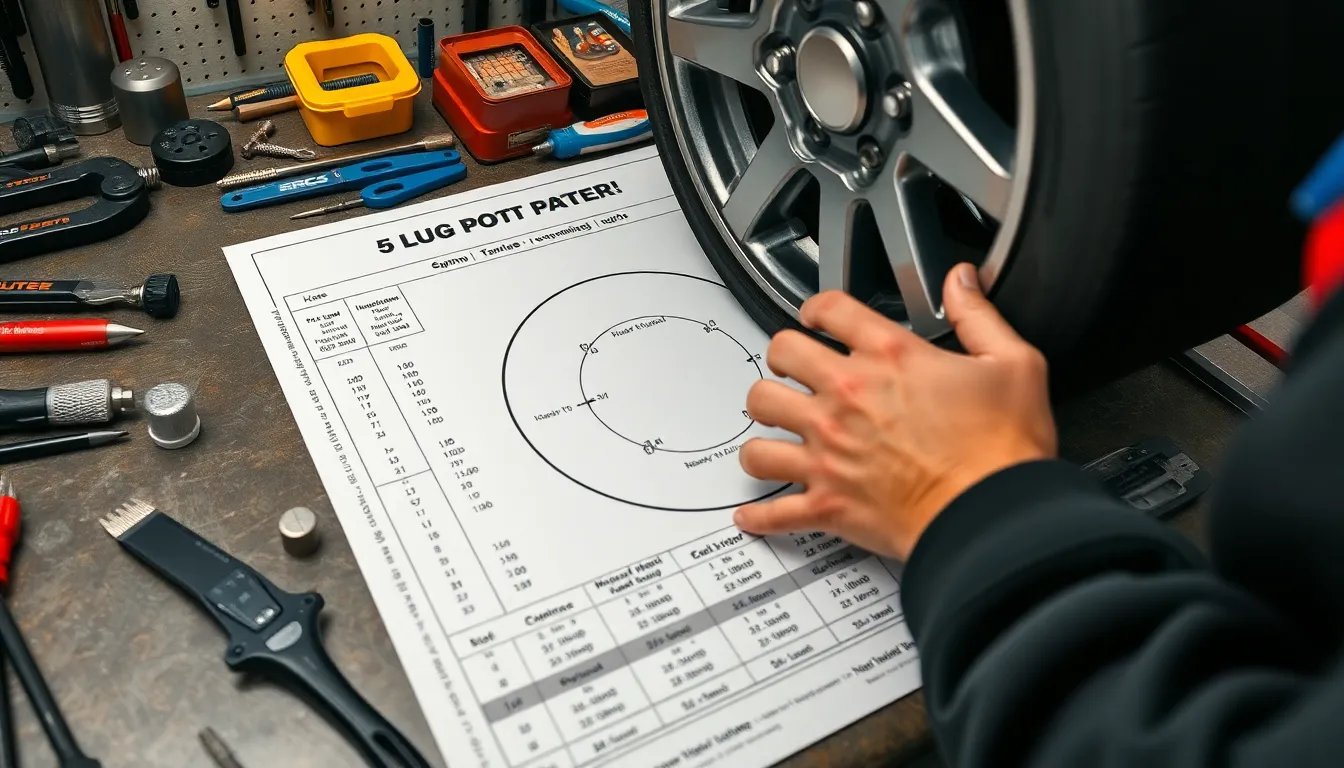
Reading a 5 lug bolt pattern chart requires systematic measurement and proper alignment techniques. We’ve developed a straightforward approach that ensures accurate pattern identification every time.
Understanding Bolt Circle Diameter Measurements
Bolt Circle Diameter (BCD) represents the diameter of the imaginary circle passing through the center of each lug hole. For 5 lug patterns, we measure from the center of one hole to the outside edge of the hole positioned after skipping one intermediate hole.
Common 5 lug patterns include these standard measurements:
| Pattern | Millimeters | Inches |
|---|---|---|
| 5×98 | 98mm | 3.86″ |
| 5×100 | 100mm | 3.94″ |
| 5×108 | 108mm | 4.25″ |
| 5×110 | 110mm | 4.33″ |
| 5×112 | 112mm | 4.41″ |
| 5×114.3 | 114.3mm | 4.5″ |
| 5×115 | 115mm | 4.53″ |
| 5×120 | 120mm | 4.72″ |
| 5×127 | 127mm | 5.0″ |
Each measurement corresponds to exact vehicle manufacturers and model years. European vehicles typically use metric measurements while American manufacturers often employ imperial specifications.
Identifying Your Vehicle’s Exact Pattern
Download and print the chart at 100% scale to maintain measurement accuracy. Position the printed chart directly over your wheel’s lug holes to align the template holes with your actual lugs.
Verify alignment by checking that all five holes match perfectly with the chart markings. Misalignment indicates an incorrect pattern selection requiring adjustment to find the proper match.
Measure manually if chart alignment proves difficult by determining the distance between the center of the first lug and the outside edge of the next lug after skipping one position. This measurement equals your bolt circle diameter and corresponds directly to the chart specifications.
Cross reference your measurement with the chart’s conversion table to confirm both metric and imperial values. Popular patterns like 5 on 4.5″ (5×114.3mm) and 5 on 5″ (5x127mm) appear frequently across multiple vehicle manufacturers and require precise identification for proper wheel fitment.
Top Features to Look for in a Quality Printable Chart
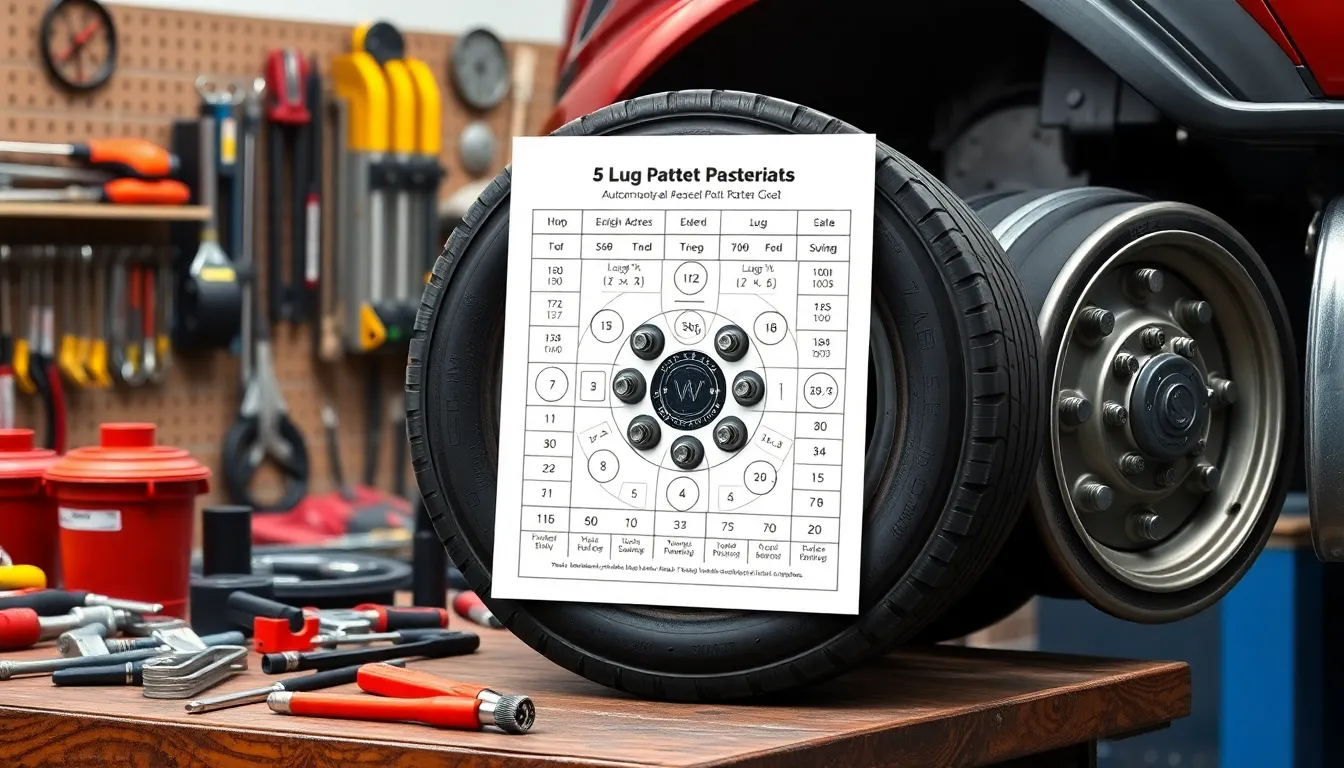
Selecting the right printable 5 lug bolt pattern chart requires attention to exact features that ensure accuracy and usability. We’ve identified three essential characteristics that separate professional-grade charts from basic templates.
Clear Measurement Markings
Quality printable charts display bolt circle diameter measurements in both inches and millimeters with precise, easy-to-read markings. The chart displays hole sizes and spacing with numerical values that allow accurate measurement verification. Measurement lines appear crisp and dark enough to remain visible after printing on standard paper.
Professional charts include diameter markings for common 5 lug patterns such as 5×4.5″ (114.3 mm), 5×4.75″ (120.7 mm), and 5×5″ (127 mm). Each measurement point contains corresponding metric and imperial values to accommodate different measuring preferences. Calibration marks help users verify their printed chart maintains proper scale accuracy.
Comprehensive Vehicle Coverage
Effective printable charts cover the complete range of 5 lug bolt patterns found across automotive applications. Coverage extends from compact car patterns like 5×4.5″ (114.3 mm) used in Honda and Toyota vehicles to larger truck patterns such as 5×5.5″ (139.7 mm) common in Ford and Chevrolet applications.
Complete coverage includes intermediate sizes like 5×4.75″ (120.7 mm) and 5×5″ (127 mm) that appear in various domestic and import vehicles. Trailer applications receive attention through inclusion of specialized patterns used in utility and boat trailers. The chart organizes patterns by size progression rather than vehicle type to streamline identification processes.
Durable Print Quality
Charts designed for workshop environments maintain clarity and accuracy through repeated handling and use. Print quality specifications ensure measurement lines remain sharp when reproduced on standard 8.5″x11″ paper at 100% scale. Heavy paper stock or lamination options extend chart lifespan in professional shop environments.
Workshop durability features include resistance to oil stains and moisture that commonly occur during wheel service procedures. Clear coating compatibility allows charts to withstand cleaning solvents without measurement distortion. Reinforced hole punch areas prevent tearing during template cutting and repeated alignment procedures.
Best Sources for Printable 5 Lug Bolt Pattern Charts
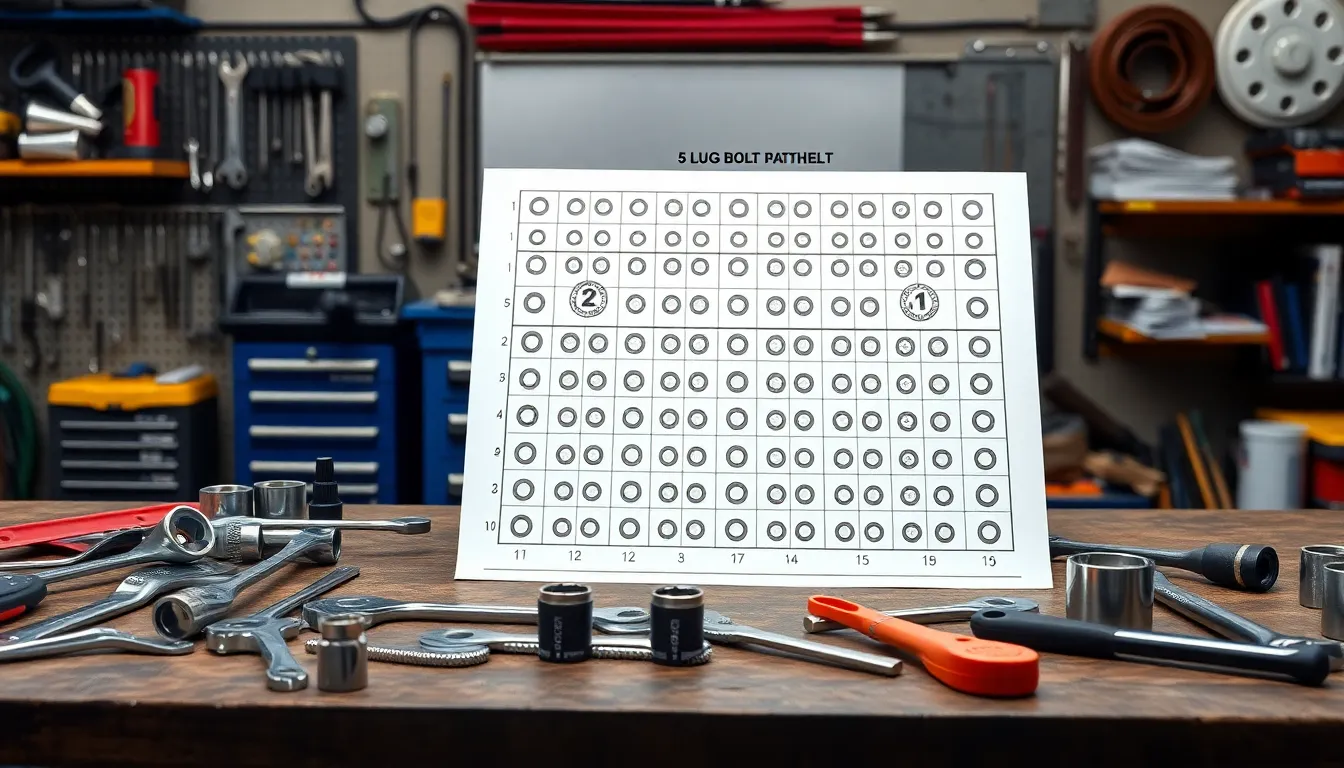
Several reputable automotive websites provide free downloadable templates that eliminate guesswork from wheel fitment verification. These resources offer professional-grade accuracy without requiring specialized measuring equipment.
Free Online Resources
We’ve identified multiple websites that offer completely free printable bolt pattern templates for 5 lug wheels. RecStuff.com provides straightforward printable templates supporting various patterns including the standardized 5-bolt on 4.5″ configuration, designed primarily for trailer wheels but versatile enough for automotive applications. Users can print these templates, cut them out, and place them directly over wheel studs to confirm fitment instantly.
eTrailer.com delivers downloadable trailer bolt hole pattern templates that print accurately on standard 8.5×11″ paper. Their templates adapt well for automotive use even though being initially designed for trailer applications. The download process requires no registration or fees, making these resources accessible for immediate use.
Eastern Marine offers printable bolt circle templates specifically calibrated for 5 lug wheels, hubs, and drums. Their templates must maintain an outer diameter of 7-1/8″ when printed to ensure measurement accuracy. This precision requirement makes their templates particularly valuable for verifying compatibility before purchasing replacement components.
Professional Automotive Websites
MPBrakes.com stands out by providing a comprehensive “Print Your Own Wheel Bolt Pattern Guide” that specifically addresses the unique challenges of measuring 5 lug patterns. Their guide instructs users to measure from the center of one hole, skip a hole in either direction, and measure to the outside edge of that hole for accurate results. Printable templates accompany detailed instructions, helping users identify wheel bolt patterns without measurement uncertainty.
Professional tire shops and automotive retailers frequently reference these same resources during customer consultations. The templates from these websites undergo regular updates to include newer vehicle patterns and maintain accuracy standards. Workshop environments benefit from the durability these professionally designed templates provide, withstanding repeated handling while maintaining clear measurement markings.
Both DIY enthusiasts and professional mechanics rely on these sources for their combination of accuracy, accessibility, and cost effectiveness compared to specialized measuring tools.
How to Print and Use Your Chart Effectively
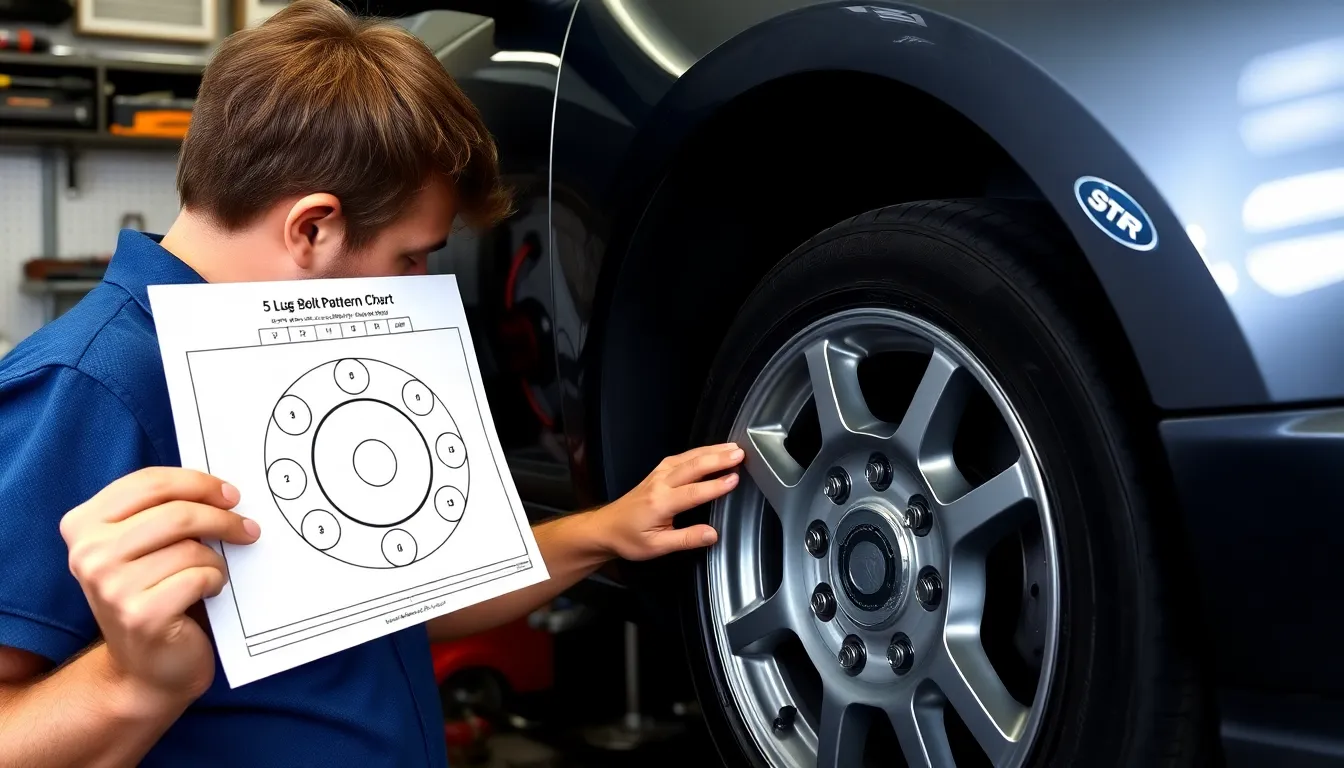
Proper printing and handling techniques ensure your 5 lug bolt pattern chart delivers accurate measurements every time. Getting the setup right from the start saves time and prevents costly wheel fitment errors.
Optimal Print Settings and Paper Choice
Printer settings make the difference between an accurate measurement tool and a useless template. Set your printer to “Actual Size” or 100% scale to maintain precise dimensions – scaling options distort measurements and render the chart ineffective. Download high-quality PDF files from reputable automotive websites like RecStuff.com or eTrailer.com for the clearest print results.
Standard 8.5×11″ paper works for most 5 lug bolt pattern templates. Heavy-duty cardstock or 32lb paper provides superior durability for workshop environments where charts face repeated handling. Color printing helps distinguish different bolt patterns when charts include multiple templates on one page. Black and white printing suffices for single-pattern charts while reducing ink costs.
Test your printer’s accuracy by measuring known dimensions on the printed chart before first use. Print quality affects measurement precision – ensure ink cartridges contain sufficient levels and paper feeds correctly to avoid skewing. Replace worn printer components that cause smudging or uneven printing which compromises template accuracy.
Practical Storage and Reference Tips
Lamination protects your printed 5 lug bolt pattern chart from grease and moisture in automotive environments. Clear laminating pouches preserve chart readability while allowing easy cleaning between uses. Store laminated charts in toolbox compartments alongside other measuring instruments for quick access during wheel installations.
Digital backups prevent reprinting hassles when physical charts become damaged or lost. Save PDF files to cloud storage accounts and mobile devices for immediate access at parts stores or salvage yards. Vehicle maintenance folders benefit from including printed charts exact to your car’s bolt pattern for reference during repairs.
Workshop organization improves when charts stay near wheel mounting equipment. Magnetic holders attach templates to metal surfaces for hands-free reference while working. Plastic sleeves protect charts from workshop debris while maintaining visibility of measurement markings and pattern specifications.
Create reference sets for common bolt patterns your shop encounters frequently. Organize charts by bolt circle diameter for faster pattern identification during busy service periods. Label storage containers clearly to help technicians locate exact templates quickly during wheel fitment verification processes.
Common 5 Lug Bolt Patterns by Vehicle Brand
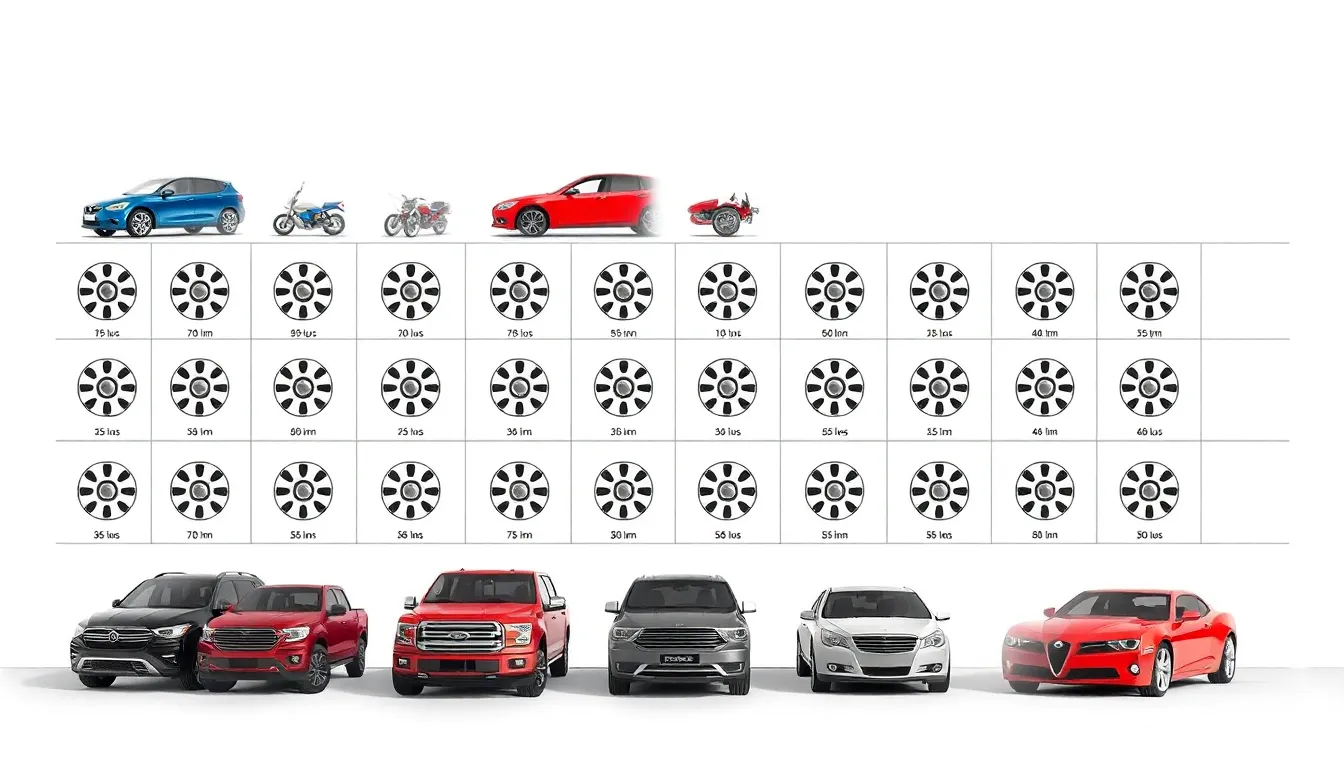
Different automotive manufacturers adopt exact bolt patterns that remain consistent across their vehicle lineups. Understanding these brand-exact patterns helps streamline wheel selection and reduces compatibility confusion.
Ford and Chevrolet Patterns
Ford passenger vehicles predominantly feature the 5×114.3 mm (5×4.5 inches) bolt pattern across popular models like Mustang, Taurus, and Edge. This measurement represents the standard configuration that Ford maintains throughout most of their mainstream vehicle lineup.
Some Ford trucks and SUVs use the 5×135 mm pattern, though this application remains less common among standard passenger cars. The larger pattern accommodates heavier duty applications where increased load capacity becomes essential.
Chevrolet employs 5×120 mm for select premium models including certain Corvette series and SUV variants. Many mainstream Chevrolet cars share the 5×114.3 mm (5×4.5 inches) pattern with other American automotive brands, creating cross-compatibility opportunities for wheel upgrades.
Honda and Toyota Specifications
Honda maintains consistency by using 5×114.3 mm (5×4.5 inches) across most Accord, Civic (post-2001), and CR-V models. This standardization simplifies wheel selection for Honda owners and creates compatibility with many aftermarket wheel options.
Toyota follows a similar approach with 5×114.3 mm (5×4.5 inches) measurements for popular models including Camry, Corolla, RAV4, and Highlander. The widespread adoption of this pattern among Japanese manufacturers creates extensive aftermarket support and replacement part availability.
European Vehicle Standards
European manufacturers carry out distinct bolt patterns that reflect their engineering preferences and regional standards. Audi, Mercedes-Benz, and Volkswagen frequently use 5×112 mm or 5×120 mm depending on exact model requirements and production years.
BMW maintains 5×120 mm across many models throughout their wheel applications, creating consistency within their brand network. This pattern accommodates the performance requirements and engineering specifications that BMW implements across their vehicle range.
Volvo uses 5×108 mm or 5×114.3 mm depending on the exact model, with pattern selection often correlating to vehicle size and intended market positioning.
| Brand | Common Pattern | Alternative Pattern |
|---|---|---|
| Ford | 5×114.3 mm | 5×135 mm |
| Chevrolet | 5×114.3 mm | 5×120 mm |
| Honda | 5×114.3 mm | – |
| Toyota | 5×114.3 mm | – |
| BMW | 5×120 mm | – |
| Audi/Mercedes/VW | 5×112 mm | 5×120 mm |
| Volvo | 5×108 mm | 5×114.3 mm |
Conclusion
We’ve shown you how a printable 5 lug bolt pattern chart becomes an essential tool for anyone working with vehicle wheels. These charts eliminate the confusion and costly mistakes that often come with wheel fitment projects.
Whether you’re a professional mechanic or a DIY enthusiast we believe having accurate measurement tools at your fingertips makes all the difference. The free resources we’ve highlighted provide reliable templates that work just as well as expensive specialized equipment.
Remember to print your charts at actual size and store them properly for long-term use. With the right chart in hand you’ll confidently verify bolt patterns and make informed wheel purchasing decisions every time.
Frequently Asked Questions
What is a 5 lug bolt pattern and why is it important?
A 5 lug bolt pattern refers to the arrangement of five bolt holes on a vehicle’s wheel hub. It’s crucial for wheel fitment because it determines which wheels are compatible with your vehicle. The pattern includes the bolt circle diameter (BCD) – the diameter of an imaginary circle through the center of each lug hole. Using an incorrect pattern can compromise vehicle safety and performance.
How do I read a 5 lug bolt pattern chart?
To read a 5 lug bolt pattern chart, first print it at 100% scale for accuracy. Align the chart with your vehicle’s lug holes, ensuring proper positioning. The chart displays measurements in both metric and imperial units. Cross-reference your alignment with the conversion table to confirm your vehicle’s specific pattern, such as 5×114.3 or 5×120.
What are the most common 5 lug bolt patterns?
The most common 5 lug bolt patterns include 5×100, 5×108, 5×110, 5×112, 5×114.3, 5×115, 5×120, and 5×127. The 5×114.3mm pattern is particularly popular, used by Ford, Honda, Toyota, and Chevrolet. European manufacturers like BMW often use 5x120mm, while Audi and Mercedes-Benz typically use 5x112mm patterns.
Where can I download a free printable 5 lug bolt pattern chart?
Several reputable automotive websites offer free downloadable charts, including RecStuff.com, eTrailer.com, Eastern Marine, and MPBrakes.com. These sources provide accurate templates for both trailer and automotive applications. The charts are designed to eliminate guesswork and provide reliable measurements without requiring specialized tools.
How should I print the bolt pattern chart for accurate measurements?
Set your printer to “Actual Size” or 100% scale to maintain accurate dimensions – never use “Fit to Page.” Use high-quality, durable paper that can withstand repeated handling in workshop environments. Consider laminating the chart for protection and longevity. Keep both digital backups and physical copies organized near your wheel mounting equipment.
What bolt patterns do different car manufacturers typically use?
Ford predominantly uses 5×114.3mm for most passenger vehicles. Chevrolet uses both 5×114.3mm and 5x120mm patterns. Honda and Toyota standardize on 5×114.3mm. European manufacturers vary: BMW uses 5x120mm, while Audi, Mercedes-Benz, and Volkswagen often use 5x112mm or 5x120mm. Volvo patterns vary between 5x108mm and 5×114.3mm depending on the model.
Can I use a bolt pattern chart instead of measuring tools?
Yes, a quality printable bolt pattern chart can effectively replace expensive specialized measuring tools for most applications. These charts provide accurate measurements when printed correctly and offer a cost-effective solution for DIY mechanics and small repair shops. However, ensure you’re using a reputable source and following proper alignment procedures for reliable results.
What should I look for in a quality printable bolt pattern chart?
Look for charts with clear measurement markings in both inches and millimeters, comprehensive vehicle coverage across various manufacturers, and durable print quality. Quality charts should include precise bolt circle diameter measurements, cover specialized patterns for trailers, and maintain clarity after repeated handling. Choose charts from reputable automotive sources for accuracy and reliability.



